随着我国集约化养殖业的快速发展, 每年都会产生大量的猪粪.猪粪的养分含量较高, 是一种良好的潜在肥源[1].然而, 在养殖过程中饲料添加剂的过度使用, 导致猪粪中重金属含量普遍较高, 尤其以Cu、Zn含量最为显著[2].猪粪的直接农田施用不仅会危害作物的生长, 也有造成环境污染的风险[3].因此猪粪农用之前一般需经过堆肥处理, 促使其转化为稳定、安全、无害的有机肥料[4].然而传统的堆肥工艺存在重金属钝化效率不高及产品品质低下等问题, 限制了堆肥产业的发展和有机固体废物的快速消纳[5, 6].为了改进这些缺点, 现代堆肥工艺立足于高效高品质有机肥的生产, 注重堆肥过程和施用风险的控制.其中, 在堆肥过程中引入廉价易得的矿物添加剂就是现代堆肥工艺中的一种有效工程措施[7~9].例如, Wang等[6]指出麦饭石辅助猪粪堆肥对Cu、Zn的钝化作用显著, 添加比例为10%时能使堆肥过程中NH3和N2O的排放量分别减少48.76%和85.26%. Li等[1]发现添加钠基膨润土能有效降低猪粪堆肥中重金属(Cu、Zn)活性, 促进有机质的矿化分解, 且添加比例不宜超过2.5%. Chen等[10]的研究表明添加生物炭可以提高堆肥过程中重金属(Cu、Zn、Cd、Cr)的钝化效率, 缩短堆体升温时间.
综上所述, 加入一定比例的矿物添加剂可以有效钝化重金属, 改善堆肥进程[11].然而, 堆肥作为有机肥料, 土壤是其最终的归宿.猪粪堆肥中Cu、Zn总量仍然较高, 长期施用容易导致农田Cu、Zn污染, 加重作物中重金属元素的累积[12, 13].同时重金属的生物有效性与其化学形态密切相关[14~16], 在土壤中重金属形态易受到pH、氧化还原电位、有机质和阳离子交换量等因素的变化而重新分布[17].添加矿物质能够有效钝化堆肥中的重金属, 而在土壤施用矿物添加剂辅助堆肥后, 其对土壤中Cu、Zn生物有效性及作物吸收Cu、Zn的影响, 目前尚不明确.由此可知, 深入探究矿物添加剂对堆肥过程及土地利用中重金属形态变化的影响, 对促进畜禽粪便堆肥的安全农用具有重要意义.
钙基膨润土在我国矿产丰富, 价廉易得, 有着良好的吸附和离子交换能力[2].前期研究[2, 18]表明添加钙基膨润土能有效降低堆肥初期氮素损失, 促进有机质的降解及腐熟度的提升.在此基础上, 本研究以钙基膨润土为堆肥辅助剂, 结合盆栽试验来探究钙基膨润土对堆肥过程以及土壤施用堆肥后Cu、Zn形态分布的影响, 同时评价其在改善作物吸收重金属方面的应用潜力, 以期能探明钙基膨润土固定堆肥重金属的实际功效, 同时为矿物添加剂辅助堆肥工艺的应用推广提供理论依据.
1 材料与方法 1.1 堆肥试验本研究供试材料为杨凌规模化养殖场的新鲜猪粪, 调理剂木屑出自杨凌周边家具厂, 钙基膨润土购置于山东潍坊华潍有限公司.堆肥原料基本理化性质见表 1, 堆制方法详见文献[2].试验中, 将猪粪和木屑按干基2:1比例混合, 然后添加干基质量0%、2.5%、5%、7.5%和10%的钙基膨润土, 共设置5个处理, 分别记为0% CB、2.5% CB、5% CB、7.5% CB和10% CB, 调节含水率60%左右, 混匀后转移入自制半自动搅拌式好氧堆肥反应器[1]进行为期60 d好氧堆肥, 于1、3、7、14、21、30、45和60 d采集样品.堆肥结束后, 自然风干腐熟堆肥, 开展盆栽试验.
|
|
表 1 堆肥原料基本理化性质 Table 1 Physicochemical properties of composting materials |
1.2 盆栽试验
盆栽土取自西北农林科技大学试验站农田表层土, 土壤类型为黄褐土:pH 8.04、电导率0.40 mS·cm-1、有机质1.04%、Cu 20.61 mg·kg-1、Zn 64.52 mg·kg-1.土壤和堆肥粉碎过2 mm筛.盆栽装置为上口直径28 cm、下口直径16 cm、高18 cm的塑料盆, 填装总质量为3 kg, 肥土比为2.5% (湿基质量), 每个处理3个重复, 加去离子水至田间持水量的70%, 放置两周使各组分稳定化.供试植物为常见蔬菜白菜, 每盆均匀播种20粒, 放置于西北农林科技大学温室大棚, 待植株萌发4个叶片后进行间苗, 均匀保留5株幼苗, 40 d后收获白菜地上部分.
1.3 测定方法堆肥和白菜采用HNO3-HClO4消解, 土样采用HNO3-HCl-HClO4消解, 日立Z-3000型原子吸收分光光度计测定Cu、Zn总量; 重金属形态采用改进BCR连续提取法测定[19], 操作要点见表 2; 白菜收获后经过杀青、烘干至恒重后记录干重; pH和电导率EC采用电极法测定(水土质量比5:1)[18]; 有机质及原材料总凯氏氮和总磷测定方法见文献[20].
|
|
表 2 改进BCR连续提取法操作要点 Table 2 Scheme of modified BCR sequential extraction |
重金属形态分级为可交换态(X-EXC)、可还原态(X-RED)、可氧化态(X-OXI)、残渣态(X-RES), X代表Cu、Zn.因为堆肥过程中重金属含量变化较大, 为了更好地进行比较, 堆肥样品采用各形态占总量的质量分数进行表示.试验中土壤和堆肥重金属总量测定采用标准物质GBW08502, 植物样品用GBW10014分别进行分析质量控制.堆肥和土壤重金属形态分析试验回收率为91.86%~105.28%.
1.4 数据处理采用Origin 8.5软件进行图表绘图, SPSS 19.0进行数据显著性检验以及相关性分析.
2 结果与讨论 2.1 堆肥过程中Cu、Zn总量的变化堆肥过程中各处理Cu、Zn总量变化如图 1所示, 随着CB辅助比例的增加, 各处理初始物料中重金属含量逐渐降低, 这是由于CB中Cu、Zn含量低于猪粪, 对堆体有一定的稀释作用[6, 14].随着堆肥的进行, 0%~10% CB的处理中Cu、Zn含量逐渐上升, 这是因为有机质的降解及水分散失会导致堆体浓缩[1].堆肥结束时各处理Cu、Zn总量的增幅分别为14.92%~35.41%、12.71%~25.73%, 与毛晖等[21]报道的Cu (28.8%~32.9%)和Zn (12.3%~17.3%)结果相似, 但与郭靖等[22]报道的鸡粪堆肥中Cu、Zn增幅分别为1.68%~4.71%和4.03%~11.46%的结果存在一定差异.这是由于堆肥中重金属总量变化受堆肥原料和外部条件(如堆肥方式、天数等)的影响较大[14, 21], 不同堆肥原料的有机质降解速率及CO2释放速率不同, 因而导致了不同研究结果之间Cu、Zn的相对浓缩效应有所差异[14].
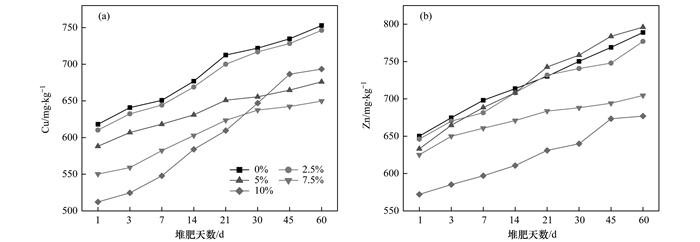
|
图 1 堆肥过程中Cu、Zn总量变化 Fig. 1 Changes in the total contents of Cu and Zn during composting of pig manure |
与重金属总量相比, 重金属的化学形态能更精确的反映其在环境中的生物有效性[23], 并且可交换态和可还原态的生物活性较高, 常将其统称为生物可利用态(X-BF; X为Cu、Zn)[14, 15].堆肥过程中不同处理Cu形态变化如图 2所示.随着堆肥的进行, 各处理中Cu-EXC和Cu-RED质量分数逐渐降低, 而Cu-OXI逐渐升高, Cu-RES略有增加.堆肥结束后, Cu形态分布以可氧化态为主, 占其总量的61.85%~73.56%, 与Meng等[16]的研究结果相印证.这是由于随着堆肥的进行, 大量增加的腐殖质会通过羧基及酚基等有机官能团对Cu(Ⅱ)产生较强的络合能力, 促使Cu-EXC和Cu-RED向Cu-OXI转化[24].堆肥结束后与对照相比, 2.5%~10% CB可使Cu-BF的分布比例降低19.84%~48.90%, 促进Cu的化学形态向生物有效性低的方向转化, 并且10% CB处理效果最显著.
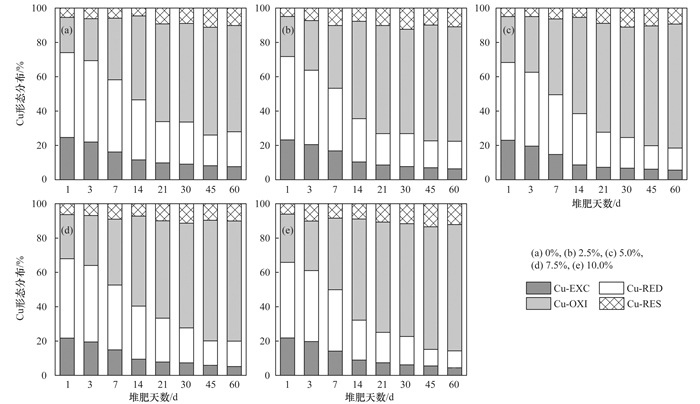
|
图 2 添加钙基膨润土堆肥过程中Cu形态变化 Fig. 2 Changes in the Cu fractions during composting of pig manure amended with Ca-bentonite |
堆肥过程中Zn的各形态分布与Cu有所不同(图 3).随着堆肥的进行, 各处理中Zn-EXC逐渐降低, Zn-RED逐渐升高, Zn-OXI和Zn-RES略有增加, 这与侯月卿等[25]的研究结果具有一定的相似性.堆肥结束后, Zn以可还原态为主, (占60.85%~69.24%), 而此时Cu主要以可氧化态存在.造成这一差异的原因可能是由于Zn与腐殖物质的结合能力弱于Cu, 而与铁锰氧化物的结合能力较强, 在堆肥过程中有利于Zn-RED的转化[26].堆肥结束后与0% CB相比, 2.5% CB、5% CB、7.5% CB和10% CB处理中Zn-BF分布比例分别下降了8.25%、4.94%、12.28%和16.39%.结果与Cu类似, CB辅助有利于降低堆肥处理中Zn的生物有效性, 并以10% CB处理的效果最明显.其原因可能是多方面的:第一, CB的添加提高了堆体孔隙度, 微生物大量繁殖的同时使得腐殖物质含量增加, Cu的形态向较为稳定的可氧化态转化[14, 26], 生物有效性降低; 第二, CB本身为多孔矿物质, 具有较强的物理吸附和离子交换能力, 且其表面能形成呈电负性的水合氧化物薄膜, 有助于络合吸附重金属, 从而降低重金属的生物有效性[27]; 第三, CB呈碱性(pH 8.4), 对重金属有一定的钝化作用[28].
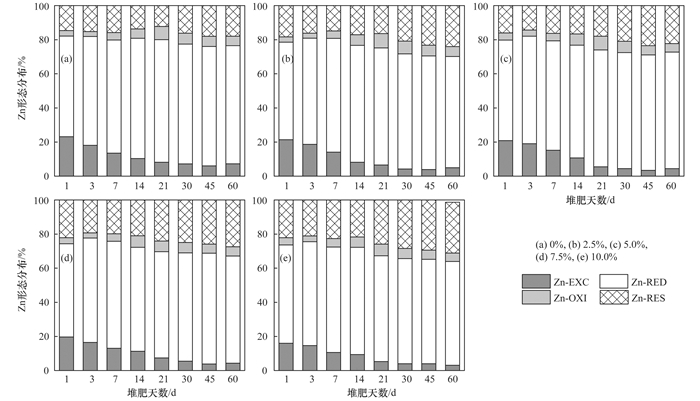
|
图 3 添加钙基膨润土堆肥过程中Zn形态变化 Fig. 3 Changes in the Zn fractions during composting of pig manure amended with Ca-bentonite |
与纯土处理相比, 施加堆肥后土壤初始pH有所下降, 而CB辅助堆肥的处理中土壤pH随辅助比例的增加而升高[图 4(a)], 这主要是由于堆肥施用到土壤后有一定的缓冲作用[29].经过40 d的种植过程, 纯土及0%~10% CB处理中土壤pH分别增加了0.42、0.57、0.61、0.51、0.65和0.64, 究其原因可能是有机碳的矿化分解以及随之产生的OH-与土壤中K+、Ca+、Mg2+等进行了离子交换[30].

|
图 4 盆栽试验前后土壤pH、EC、有机质变化 Fig. 4 Changes in the pH, EC, and organic matter content in soil before and after pot experiment |
EC代表土壤水溶性盐分含量, 对作物生长具有重要的作用.施加堆肥显著提高了(P < 0.05)土壤EC值[图 4(b)], 随着种植过程的进行, 纯土及0%~10% CB处理中EC的降幅为26.46%~37.28%, 这与蔡函臻等[20]的研究结果相印证, 可能由于水溶性盐分被植物吸收以及CB的吸附或共沉淀作用导致[18].
种植前后土壤有机质变化见图 4(c).施加堆肥后显著提高了土壤有机质含量, 其中CB辅助处理中有机质含量低于0% CB.盆栽试验结束后, 0%~10% CB处理中有机质含量分别下降了3.51%、3.22%、2.68%、2.71%和2.54%, 由此说明钙基膨润土能够稳定土壤中的有机质. Zhang等[31]通过盆栽试验研究表明, 土壤中微生物对调控有机碳的矿化分解作用显著, 而CB为微生物提供了大量的附着位点, 有利于土壤中微生物的生长繁殖, 因此CB可能通过影响土壤微生物活性间接地稳定土壤有机质.
2.4 盆栽种植前后土壤Cu、Zn形态变化与纯土相比, 施入堆肥后土壤中不同形态Cu含量显著(P < 0.05)上升[图 5(a)], 各处理Cu的形态分布为Cu-RES>Cu-RED>Cu-OXI>Cu-EXC.经过40 d的盆栽试验, 土壤中Cu-EXC和Cu-RED含量增加, Cu-OXI和Cu-RES含量降低, Cu的生物有效性提高, 这与商和平等[32]的研究结果大致相同.盆栽土壤偏碱性[图 4(a)], 堆肥中的腐殖物质在土壤环境中进一步分解, 促使与有机质结合的Cu向Cu-EXC和Cu-RED方向转化[28].相比0% CB, 2.5%~10% CB处理中土壤Cu-BF含量分别增加了35.72%、23.02%、60.56%和64.36%, 表明CB随堆肥施入土壤后对Cu的生物有效性有一定促进作用, 且2.5%~10% CB处理中白菜的Cu吸收量高于对照, 与此结果相印证.
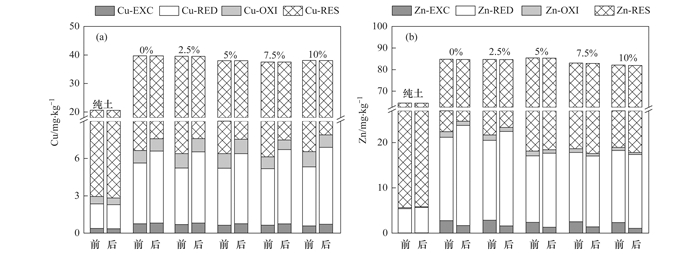
|
图 5 盆栽试验前后土壤Cu、Zn形态变化 Fig. 5 Changes in the Cu and Zn fractions in soil before and after pot experiment |
盆栽种植前后土壤中Zn形态变化如图 5(b)所示.各处理土壤Zn的形态分布为Zn-RES>Zn-RED>Zn-EXC>Zn-OXI, 盆栽结束后, 0%~10% CB处理中仅Zn-RED含量上升.这是由于Fe、Mn氧化物对Zn具有较强的吸附作用, 同时土壤pH对重金属在土壤中的迁移性和生物有效性具有重要影响[33], pH的上升[图 4(a)]更能促进这一吸附效果[14].改进BCR法提取的4种化学形态中以可交换态的生物有效性最高, 各处理种后土壤中Zn-EXC含量分别降低了38.91%、43.69%、46.02%、45.12%和54.65%, 表明CB辅助堆肥施入土壤后对Zn活性仍有抑制作用, 并且2.5%~10% CB处理中白菜Zn含量显著(P < 0.05)低于0% CB处理[图 6(b)], 与此结果相印证.究其原因可能是CB比表面积巨大, 对重金属有较强的吸附和离子交换作用, 降低了土壤中Zn的生物有效性[2].
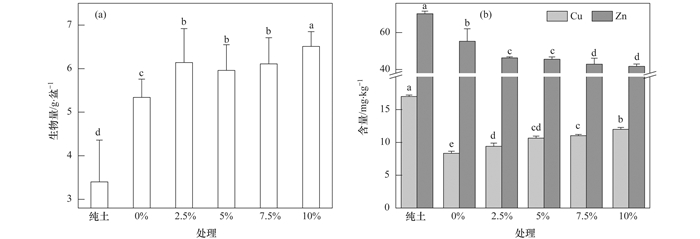
|
不同字母代表数据在 p<0.05下差异显著 图 6 白菜生物量及Cu、Zn吸收量 Fig. 6 Biomass and contents of Cu and Zn in Chinese cabbage |
白菜生物量及Cu、Zn含量如图 6所示. 0%~10% CB处理中白菜生物量分别比纯土处理增加了57.06%、80.59%、75.29%、79.71%和91.47%, 施用堆肥显著提高白菜生物量.同时CB辅助堆肥的提升效果要优于对照, 有利于作物生长.
施用堆肥在白菜增产的同时降低了Cu、Zn吸收量, 降幅分别为30.25%~50.97%和21.28%~40.81%, 这是由于施入堆肥后带来的有机物质会吸附土壤中的重金属离子, 对植物的吸收有抑制作用[24]. CB辅助堆肥降低了白菜对Zn的吸收量, 与0% CB处理相比, 10% CB中Zn的吸收量降低了25.94%, 但在2.5%~10% CB处理中Cu的吸收量增加了12.85%~43.94%. CB辅助堆肥抑制了白菜对Zn的吸收, 而对Cu则作用相反, 同时在土地利用过程中对土壤中Zn的活性仍保持抑制作用, 但对Cu则有活化的可能.为了分析这一现象, 进一步对数据进行Pearson相关性分析(表 3).虽然影响土壤Cu、Zn形态变化及白菜吸收的原因是多方面的, 但就本试验而言, 白菜对Cu的吸收量与土壤中Cu-RED含量正相关, 而CB辅助堆肥恰好可以提高Cu-RED的含量, 由此导致白菜对Cu的吸收量增加.对于Zn而言, Zn-EXC、pH及OM均与白菜吸收量负相关, 也暗示了不同元素在土壤中与作物的吸收之间存在较大差异[2].
|
|
表 3 不同参数变化量与白菜吸收间的Pearson相关系数1) Table 3 Pearson's correlation coefficient between the changes in parameters and absorption by Chinese cabbage |
3 结论
(1) 钙基膨润土辅助堆肥降低了堆肥过程中Cu、Zn的生物有效性, 相比对照, 2.5%~10% CB能使堆肥产品Cu、Zn的生物可利用态分别降低19.84%~48.90%和4.94%~16.39%, 其中10% CB效果最为显著.
(2) 土壤施用堆肥后, 钙基膨润土辅助堆肥能持续抑制土壤中Zn的生物有效性, 促使Cu的活性略有提高.
(3) 钙基膨润土辅助堆肥可以提高白菜生物量, 抑制白菜对Zn的吸收, 而对Cu则表现出一定的促进作用.
(4) 相比而言, 以10%的添加比例进行堆肥, 在降低堆肥土地利用中重金属的环境风险以及改善作物对重金属元素累积方面具有较好的应用潜力.
| [1] | Li R H, Wang J J, Zhang Z Q, et al. Nutrient transformations during composting of pig manure with bentonite[J]. Bioresource Technology, 2012, 121: 362-368. DOI:10.1016/j.biortech.2012.06.065 |
| [2] | Wang Q, Li R H, Cai H Z, et al. Improving pig manure composting efficiency employing Ca-bentonite[J]. Ecological Engineering, 2016, 87: 157-161. DOI:10.1016/j.ecoleng.2015.11.032 |
| [3] | Zang B, Li S Y, Michel Jr F, et al. Effects of mix ratio, moisture content and aeration rate on sulfur odor emissions during pig manure composting[J]. Waste Management, 2016, 56: 498-505. DOI:10.1016/j.wasman.2016.06.026 |
| [4] | Li R H, Wang Q, Zhang Z Q, et al. Nutrient transformation during aerobic composting of pig manure with biochar prepared at different temperatures[J]. Environmental Technology, 2015, 36(7): 815-826. DOI:10.1080/09593330.2014.963692 |
| [5] | Awasthi M K, Wang Q, Ren X N, et al. Role of biochar amendment in mitigation of nitrogen loss and greenhouse gas emission during sewage sludge composting[J]. Bioresource Technology, 2016, 219: 270-280. DOI:10.1016/j.biortech.2016.07.128 |
| [6] | Wang Q, Wang Z, Awasthi M K, et al. Evaluation of medical stone amendment for the reduction of nitrogen loss and bioavailability of heavy metals during pig manure composting[J]. Bioresource Technology, 2016, 220: 297-304. DOI:10.1016/j.biortech.2016.08.081 |
| [7] |
吴娟, 何胜洲, 李国学, 等. 添加过磷酸钙的猪粪堆肥污染气体减排工艺优化[J]. 农业机械学报, 2017, 48(5): 304-312. Wu J, He S Z, Li G X, et al. Process optimization of pollutant gases emission reduction with superphosphate addition during pig manure composting[J]. Transactions of the Chinese Society for Agricultural Machinery, 2017, 48(5): 304-312. DOI:10.6041/j.issn.1000-1298.2017.05.038 |
| [8] | Zhang J Y, Chen M X, Sui Q W, et al. Impacts of addition of natural zeolite or a nitrification inhibitor on antibiotic resistance genes during sludge composting[J]. Water Research, 2016, 91: 339-349. DOI:10.1016/j.watres.2016.01.010 |
| [9] | Wang X, Selvam A, Wong J W C. Influence of lime on struvite formation and nitrogen conservation during food waste composting[J]. Bioresource Technology, 2016, 217: 227-232. DOI:10.1016/j.biortech.2016.02.117 |
| [10] | Chen Y N, Liu Y, Li Y P, et al. Influence of biochar on heavy metals and microbial community during composting of river sediment with agricultural wastes[J]. Bioresource Technology, 2017, 243: 347-355. DOI:10.1016/j.biortech.2017.06.100 |
| [11] | Awasthi M K, Wang Q, Huang H, et al. Effect of biochar amendment on greenhouse gas emission and bio-availability of heavy metals during sewage sludge co-composting[J]. Journal of Cleaner Production, 2016, 135: 829-835. DOI:10.1016/j.jclepro.2016.07.008 |
| [12] |
何梦媛, 董同喜, 茹淑华, 等. 畜禽粪便有机肥中重金属在土壤剖面中积累迁移特征及生物有效性差异[J]. 环境科学, 2017, 38(4): 1576-1586. He M Y, Dong T X, Ru S H, et al. Accumulation and migration characteristics in soil profiles and bioavailability of heavy metals from livestock manure[J]. Environmental Science, 2017, 38(4): 1576-1586. |
| [13] | Tian W, Zhang Z H, Hu X F, et al. Short-term changes in total heavy metal concentration and bacterial community composition after replicated and heavy application of pig manure-based compost in an organic vegetable production system[J]. Biology and Fertility of Soils, 2015, 51(5): 593-603. DOI:10.1007/s00374-015-1005-4 |
| [14] | Lu D, Wang L X, Yan B X, et al. Speciation of Cu and Zn during composting of pig manure amended with rock phosphate[J]. Waste Management, 2014, 34(8): 1529-1536. DOI:10.1016/j.wasman.2014.04.008 |
| [15] | Wu S H, Shen Z Q, Yang C P, et al. Effects of C/N ratio and bulking agent on speciation of Zn and Cu and enzymatic activity during pig manure composting[J]. International Biodeterioration & Biodegradation, 2017, 119: 429-436. |
| [16] | Meng J, Wang L, Zhong L B, et al. Contrasting effects of composting and pyrolysis on bioavailability and speciation of Cu and Zn in pig manure[J]. Chemosphere, 2017, 180: 93-99. DOI:10.1016/j.chemosphere.2017.04.009 |
| [17] | Baldantoni D, Leone A, Iovieno P, et al. Total and available soil trace element concentrations in two Mediterranean agricultural systems treated with municipal waste compost or conventional mineral fertilizers[J]. Chemosphere, 2010, 80(9): 1006-1013. DOI:10.1016/j.chemosphere.2010.05.033 |
| [18] |
周莉娜, 蔡函臻, 李荣华, 等. 膨润土调质对污泥堆肥的脱毒及重金属钝化和雌酮消除作用[J]. 环境科学, 2017, 38(7): 3061-3069. Zhou L N, Cai H Z, Li R H, et al. Effects of bentonite amendment on detoxification, heavy metal passivation and estrone elimination of sewage sludge compost[J]. Environmental Science, 2017, 38(7): 3061-3069. |
| [19] | Rauret G, López-Sánchez J F, Sahuquillo A, et al. Improvement of the BCR three step sequential extraction procedure prior to the certification of new sediment and soil reference materials[J]. Journal of Environmental Monitoring, 1999, 1(1): 57-61. DOI:10.1039/a807854h |
| [20] |
蔡函臻, 宁西翠, 王权, 等. 碱性固体对污泥的调质堆肥影响及产品对土壤的改良潜力[J]. 环境科学, 2016, 37(12): 4848-4856. Cai H Z, Ning X C, Wang Q, et al. Effect of alkali solids amendment on sewage sludge aerobic composting and the potential of related products on infertile soil amelioration[J]. Environmental Science, 2016, 37(12): 4848-4856. |
| [21] |
毛晖, 李荣华, 黄懿梅, 等. 添加剂对猪粪好氧堆肥过程锌和铜形态的影响[J]. 农业机械学报, 2013, 44(10): 164-171, 202. Mao H, Li R H, Huang Y M, et al. Effect of additives on forms of Zn and Cu during aerobic composting of pig manure[J]. Transactions of the Chinese Society for Agricultural Machinery, 2013, 44(10): 164-171, 202. DOI:10.6041/j.issn.1000-1298.2013.10.026 |
| [22] |
郭靖, 王英辉, 陈建新, 等. 生化黄腐酸对堆肥中氰化物及重金属的影响[J]. 环境科学与技术, 2016, 39(9): 1-7, 13. Guo J, Wang Y H, Chen J X, et al. Effects of biochemical fulvic acid on degradation of cyanide and speciation of heavy metal during composting[J]. Environmental Science & Technology, 2016, 39(9): 1-7, 13. |
| [23] |
卜贵军, 于静, 邸慧慧, 等. 鸡粪堆肥有机物演化对重金属生物有效性影响研究[J]. 环境科学, 2014, 35(11): 4352-4358. Bu G J, Yu J, Di H H, et al. Influence of organic matter evolution during composting on the bioavailability of heavy metals[J]. Environmental Science, 2014, 35(11): 4352-4358. |
| [24] | Huang M, Zhu Y, Li Z W, et al. Compost as a soil amendment to remediate heavy metal-contaminated agricultural soil:mechanisms, efficacy, problems, and strategies[J]. Water, Air, & Soil Pollution, 2016, 227(10): 359. |
| [25] |
侯月卿, 赵立欣, 孟海波, 等. 生物炭和腐植酸类对猪粪堆肥重金属的钝化效果[J]. 农业工程学报, 2014, 30(11): 205-215. Hou Y Q, Zhao L X, Meng H B, et al. Passivating effect of biochar and humic acid materials on heavy metals during composting of pig manure[J]. Transactions of the Chinese Society of Agricultural Engineering, 2014, 30(11): 205-215. DOI:10.3969/j.issn.1002-6819.2014.11.026 |
| [26] | Tella M, Bravin M N, Thuriès L, et al. Increased zinc and copper availability in organic waste amended soil potentially involving distinct release mechanisms[J]. Environmental Pollution, 2016, 212: 299-306. DOI:10.1016/j.envpol.2016.01.077 |
| [27] |
施惠生, 刘艳红. 膨润土对重金属离子Pb2+, Zn2+, Cr(Ⅵ), Cd2+的吸附性能[J]. 建筑材料学报, 2006, 9(5): 507-510. Shi H S, Liu H Y. Adsorption characteristics of bentonite to Pb2+, Zn2+, Cr(Ⅵ), Cd2+[J]. Journal of Building Materials, 2006, 9(5): 507-510. |
| [28] |
生骏, 陆文静, 王洪涛. 粉煤灰对污泥堆肥过程和土地施用后交换态重金属(Cu, Zn, Pb)的影响[J]. 环境科学, 2007, 28(6): 1367-1371. Sheng J, Lu W J, Wang H T. Effects of fly ash on the exchangeable heavy metals (Cu, Zn, Pb) during sewage sludge composting and land utilization[J]. Environmental Science, 2007, 28(6): 1367-1371. |
| [29] | Chan M T, Selvam A, Wong J W C. Reducing nitrogen loss and salinity during 'struvite' food waste composting by zeolite amendment[J]. Bioresource Technology, 2016, 200: 838-844. DOI:10.1016/j.biortech.2015.10.093 |
| [30] | Ouni Y, Lakhdar A, Scelza R, et al. Effects of two composts and two grasses on microbial biomass and biological activity in a salt-affected soil[J]. Ecological Engineering, 2013, 60: 363-369. DOI:10.1016/j.ecoleng.2013.09.002 |
| [31] | Zhang X Y, Cao Y E, Tian Y Q, et al. Short-term compost application increases rhizosphere soil carbon mineralization and stimulates root growth in long-term continuously cropped cucumber[J]. Scientia Horticulturae, 2014, 175: 269-277. DOI:10.1016/j.scienta.2014.06.025 |
| [32] |
商和平, 李洋, 张涛, 等. 畜禽粪便有机肥中Cu、Zn在不同农田土壤中的形态归趋和有效性动态变化[J]. 环境科学, 2015, 36(1): 314-324. Shang H P, Li Y, Zhang T, et al. Form tendency and bio-availability dynamics of Cu and Zn in different farm soils after application of organic fertilizer of livestock and poultry manures[J]. Environmental Science, 2015, 36(1): 314-324. |
| [33] |
孙娜, 商和平, 茹淑华, 等. 连续施用污泥堆肥土壤剖面中重金属积累迁移特征及对小麦吸收重金属的影响[J]. 环境科学, 2017, 38(2): 815-824. Sun N, Shang H P, Ru S H, et al. Effects of continuous application of sewage sludge compost on heavy metals accumulation and mobility characteristics in soil profile and on heavy metals uptake of wheat[J]. Environmental Science, 2017, 38(2): 815-824. |
 2018, Vol. 39
2018, Vol. 39


